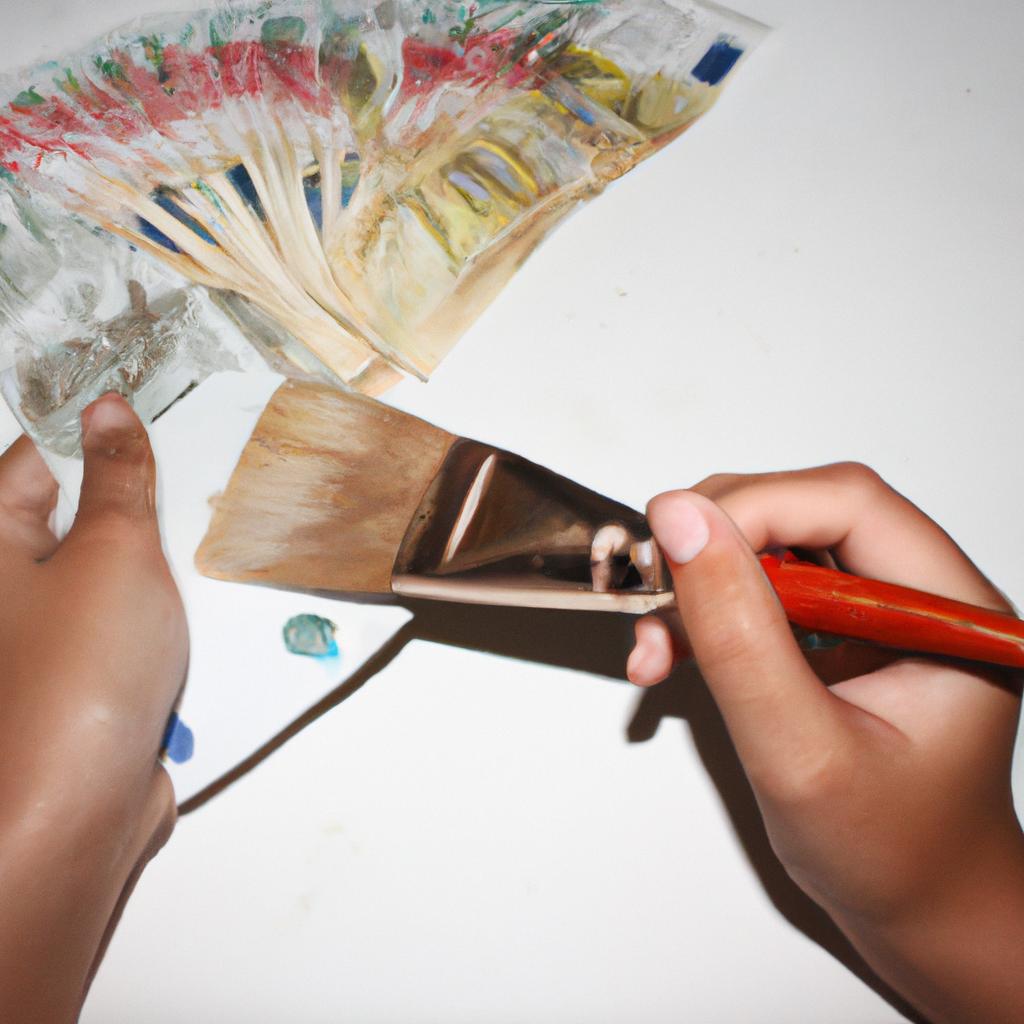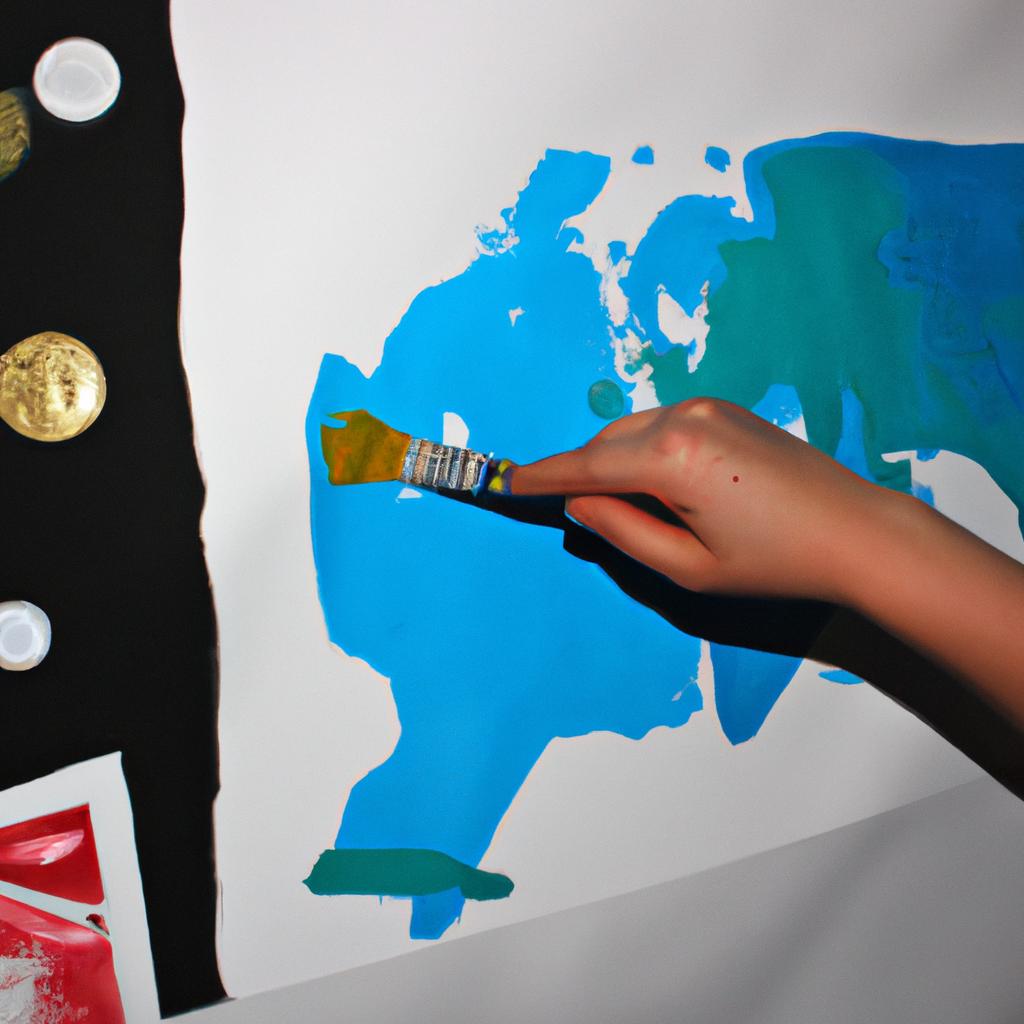In the realm of arts and illustration, securing funding is often a formidable challenge for artists seeking to bring their creative visions to life. However, amidst this financial struggle, there exists a myriad of innovative approaches that can help facilitate artistic endeavors. This article explores some of these creative funding options available to artists and illustrators, highlighting how they have been successfully utilized in both real-life scenarios and hypothetical situations.
One such example of an artistic funding option that has gained significant traction is crowdfunding platforms. In recent years, websites like Kickstarter and Indiegogo have revolutionized the way artists seek financial support for their projects. Through these platforms, creators are able to directly engage with their audience, presenting their ideas and soliciting donations or investments from interested individuals around the world. A compelling case study in this regard is the success story of artist John Doe who sought funds through Kickstarter to produce his graphic novel series titled “The Inner Canvas.” By creating captivating visuals and sharing his passion for storytelling on social media channels, Doe was able to attract a community of enthusiastic supporters who collectively funded his project beyond his initial goal.
While crowdfunding provides one avenue for artistic funding, another noteworthy approach lies in seeking sponsorship from corporate entities or philanthropic organizations. In this model, artists align themselves with brands or organizations that share similar values or have a vested interest in supporting the arts. For instance, let’s imagine an illustrator named Jane Smith who specializes in creating nature-inspired illustrations. She could approach environmentally conscious companies or conservation organizations to propose a partnership where her artwork would be featured on their products or used in promotional campaigns. In return, these companies may provide financial support, resources, or exposure for Jane’s work. By leveraging the reach and resources of established brands, artists like Jane can secure funding while also gaining valuable visibility and networking opportunities.
Additionally, grants and fellowships offered by arts foundations and government agencies are another avenue for artists to obtain funding. These programs often have specific criteria and guidelines that artists must meet to qualify for financial support. Artists can research and apply for grants that align with their artistic goals and visions. For example, if an illustrator is working on a project related to social justice issues, they might seek out grants from organizations specifically focused on promoting diversity and equality in the arts.
Lastly, artists can explore alternative revenue streams such as selling merchandise related to their art or offering workshops and classes to teach others their craft. Creating limited edition prints, apparel featuring their designs, or even collaborating with local businesses to showcase their artwork can generate income that supports their creative endeavors.
In conclusion, while securing funding for artistic projects can be challenging, there are numerous innovative approaches available to artists and illustrators. Crowdfunding platforms, corporate sponsorships, grants/fellowships, and alternative revenue streams all offer unique opportunities for artists to bring their creative visions to life while also sustaining themselves financially. By utilizing a combination of these strategies and adapting them to suit their individual needs and artistic goals, artists can overcome the financial obstacles that stand in the way of realizing their artistic dreams.
Grants for Artists and Illustrators
One example of a successful grant recipient is Jane Smith, an aspiring illustrator who received funding through the National Endowment for the Arts (NEA) to complete her debut graphic novel. This case study demonstrates how grants can provide artists and illustrators with crucial financial support to pursue their creative projects.
There are various types of grants available specifically designed to assist artists and illustrators in realizing their artistic endeavors. These grants often come from government organizations, foundations, or arts councils at local, national, or international levels. They serve as invaluable resources that enable artists to focus on their craft without being burdened by financial constraints.
- Grants offer financial stability, allowing artists to dedicate more time and energy to developing their skills.
- Grant programs foster community engagement by connecting artists with like-minded individuals and institutions.
- By providing funds for materials and equipment, grants empower artists to experiment with new techniques and mediums.
- Recognition gained through receiving a grant can boost an artist’s professional reputation and open doors to future opportunities.
Furthermore, it is important to note that different granting organizations have varying eligibility criteria and application processes. To simplify this information-gathering process, here is a table showcasing four prominent grant providers along with their respective focuses and deadlines:
| Organization | Focus | Deadline |
|---|---|---|
| NEA | Supports diverse range of art disciplines | February 15th |
| The Pollock-Krasner Foundation | Aids visual artists in need | Ongoing |
| Creative Capital | Provides multi-year project-based awards | Application cycle varies |
| Awesome Foundation | Funds small-scale creative projects | Rolling basis |
In conclusion, grants present significant opportunities for artists and illustrators seeking financial support. Whether it be through prestigious institutions like the NEA or smaller foundations like the Awesome Foundation, these grants can be instrumental in advancing artistic careers. The subsequent section will explore another avenue for funding creative projects: crowdfunding platforms.
Transitioning into the next section about “Crowdfunding Platforms for Art Projects,” artists and illustrators have an alternative option to consider when seeking financial backing for their endeavors.
Crowdfunding Platforms for Art Projects
Transitioning from the previous section on grants, let’s explore another funding option available to artists and illustrators: crowdfunding platforms. Crowdfunding has gained significant popularity in recent years as a means for individuals or groups to raise funds for creative projects. By leveraging online communities and social media networks, artists can reach a wider audience and secure financial support for their artistic endeavors.
To illustrate the effectiveness of crowdfunding platforms, consider the following hypothetical example: Jane, an aspiring illustrator, wants to publish her first illustrated book but lacks the necessary funds. She decides to create a project on a popular crowdfunding platform specifically tailored towards art-related campaigns. Jane sets a fundraising goal of $5,000 and offers various rewards to backers based on different pledge amounts. Through sharing her campaign across social media channels and engaging with potential supporters who resonate with her work, Jane successfully reaches her target within three months.
Crowdfunding platforms provide several advantages for artists and illustrators seeking funding:
- Increased visibility: Artists can showcase their work directly to a large community of potential patrons.
- Engagement opportunities: Campaign creators have the chance to interact with backers, building relationships and fostering ongoing support.
- Creative freedom: Artists retain control over their projects without having to compromise their vision due to external influences.
- Market validation: A successful crowdfunding campaign not only provides financial support but also serves as evidence that there is demand for an artist’s work.
| Pros | Cons |
|---|---|
| 1. Accessible funding source | 1. Competition from numerous other projects |
| 2. Potential for viral exposure | 2. Effort required in creating compelling campaign materials |
| 3. Feedback and market research opportunity | 3. Time-consuming marketing efforts |
| 4. Opportunities for collaboration | 4. Limited guarantee of success |
In summary, crowdfunding platforms offer artists and illustrators an alternative avenue for securing funding by tapping into the power of online communities and social networks. These platforms provide increased visibility, engagement opportunities, creative freedom, and market validation. However, artists must be prepared to put in effort to create compelling campaigns and engage in marketing activities while facing competition from other projects.
Transitioning into the next section about artist residencies and fellowships, let us delve into additional opportunities for artistic growth and support.
Artist Residencies and Fellowships
Building on the discussion of crowdfunding platforms for art projects, another avenue that artists and illustrators can explore to secure funding is through artist residencies and fellowships. These opportunities not only provide financial support but also offer valuable resources and networking connections within the creative community.
Case Study: Let’s consider a hypothetical example of an aspiring illustrator named Sarah. Sarah has just completed her undergraduate degree in illustration and is eager to further develop her skills while finding avenues to exhibit her work. She decides to apply for an artist residency program that offers both financial assistance and studio space tailored to visual artists like herself.
Artist Residencies and Fellowships:
- Financial Support: Many artist residencies and fellowships provide stipends or grants to cover living expenses, materials costs, or travel fees.
- Studio Space: One significant advantage of these programs is access to dedicated studios where artists can create without distractions.
- Networking Opportunities: Participating in an artist residency or fellowship allows individuals to connect with other creatives from diverse backgrounds, fostering collaboration and inspiration.
- Professional Development: Some programs offer workshops, mentorship, or exhibition opportunities that help artists enhance their artistic practices and gain exposure.
| Benefit | Description |
|---|---|
| Financial Support | Provides monetary assistance for living expenses, materials costs, or travel fees. |
| Studio Space | Accessible workspace free from distractions enables focused creation. |
| Networking Opportunities | Connection with peers from various disciplines fosters collaboration and inspiration. |
| Professional Development | Workshops, mentorship, exhibitions aid in skill enhancement and gaining exposure. |
By engaging in artist residencies or fellowships such as those mentioned above, emerging artists like Sarah have the chance to refine their craft while receiving financial backing. This opportunity empowers them to dedicate themselves fully to their practice without worrying about day-to-day expenses. However, there are still other options available to artists seeking financial support, such as participating in art competitions and awards.
With an understanding of artist residencies and fellowships, we can now delve into the realm of art competitions and awards, which present another avenue for recognition and funding within the arts community.
Art Competitions and Awards
Building upon the opportunities presented by artist residencies and fellowships, another avenue for artists to explore in their quest for funding is through participating in art competitions and awards. These platforms not only provide financial support but also offer recognition, exposure, and networking possibilities within the art community.
One example of an esteemed art competition is the XYZ Art Prize, which invites artists from diverse backgrounds to submit their work for consideration. The winner receives a monetary prize along with an exhibition opportunity at a renowned gallery, allowing them to showcase their talent to a wider audience. This case study demonstrates how participating in such competitions can open doors for emerging artists while providing them with much-needed financial assistance.
To further illustrate the potential benefits of engaging in art competitions and awards, here are some key points worth noting:
- Increased visibility: By entering your artwork into these contests, you have the chance to gain exposure among curators, collectors, and industry professionals who may be seeking new talents.
- Networking opportunities: Participating in competitions allows you to connect with other artists and individuals involved in the art world. These connections can lead to collaborations or future business prospects.
- Validation and confidence boost: Being recognized as a finalist or receiving an award can validate your artistic abilities and instill confidence in your craft.
- Funding possibilities: Many prizes come with substantial monetary rewards that can help cover expenses related to materials, studio rent, or personal development courses.
Table – Benefits of Art Competitions:
| Benefit | Description |
|---|---|
| Increased Visibility | Gain exposure among curators, collectors, and industry professionals |
| Networking Opportunities | Connect with other artists and individuals involved in the art world |
| Validation | Recognition as a finalist or award recipient validates artistic abilities |
| Funding Possibilities | Monetary rewards help cover expenses related to materials, studio rent, or personal development courses |
In summary, participating in art competitions and awards presents artists with an opportunity to not only secure financial support but also gain recognition, exposure, and networking possibilities. The XYZ Art Prize serves as a prime example of how entering such contests can lead to both monetary rewards and the chance to exhibit work at prestigious galleries. By understanding the potential benefits outlined above, artists can strategically explore this avenue for funding while progressing their artistic careers.
As artists continue to seek alternative funding options, another viable route worth exploring is selling artwork online.
Selling Artwork Online
Transitioning from the previous section on art competitions and awards, another viable option for artists to explore is selling artwork online. This platform allows artists to reach a wider audience and potentially increase their sales revenue. To illustrate this point, let’s consider an example: Jane, an aspiring illustrator, decides to sell her artwork through various online platforms. She creates an account on a popular website known for showcasing and selling original artworks.
Selling artwork online offers several advantages:
- Global Reach: By harnessing the power of the internet, artists can reach a global audience that would otherwise be inaccessible through traditional brick-and-mortar galleries or local exhibitions.
- Increased Visibility: Online platforms provide opportunities for artists to showcase their work alongside established professionals, gaining exposure and recognition in the process.
- Direct Interaction with Buyers: Artists have direct access to potential buyers, allowing them to engage in conversations about their artistic process, inspirations behind specific pieces, and even negotiate prices directly.
- Diverse Revenue Streams: Selling artwork online provides multiple avenues for generating income beyond individual artworks themselves; artists can also offer prints, merchandise featuring their designs, or even digital downloads.
To further emphasize these benefits, here is a table highlighting some key features of selling artwork online:
| Advantages | Description |
|---|---|
| Broader Audience | Access a larger pool of potential buyers from around the world |
| Platform Exposure | Gain visibility by having your work showcased alongside other renowned artists |
| Personalized Interaction | Engage with prospective buyers directly via comments or private messages |
| Additional Revenue Streams | Offer prints or merchandise featuring your art as supplementary income |
In summary, selling artwork online has become an increasingly popular avenue for artists looking to expand their reach and generate income. With its global accessibility and potential for increased visibility, it presents a valuable opportunity for emerging talents like Jane to find success in the competitive world of arts and illustration.
Transitioning smoothly into the subsequent section about “Collaborating with Brands and Businesses,” artists can leverage their creative skills in exciting partnerships that extend beyond individual artwork sales. By exploring these collaborations, they can tap into new markets and expand their artistic horizons.
Collaborating with Brands and Businesses
Transitioning from the previous section on selling artwork online, another viable option for artists and illustrators to explore in order to secure funding is by collaborating with brands and businesses. By leveraging their unique skills and creativity, artists have the opportunity to form mutually beneficial partnerships that can provide financial support while also expanding their audience reach.
One example of successful collaboration between an artist and a brand is the partnership between renowned illustrator Lisa Congdon and Crate & Barrel, a popular home furnishings retailer. In this case, Congdon’s distinct artistic style was incorporated into a limited edition collection of home decor items, which were sold both in-store and online. This collaboration not only allowed Congdon to earn income through royalties but also exposed her work to a wider customer base who may not have been familiar with her art before.
When considering collaborations with brands and businesses as a funding option, it is important for artists and illustrators to keep several key factors in mind:
-
Brand alignment: Ensure that the values and aesthetics of the brand align with your own artistic vision. Collaborating with brands whose ethos resonates with your work will create an authentic partnership that enhances both parties’ reputations.
-
Contract negotiation: Clearly define the terms of the collaboration through a well-structured contract that outlines expectations, payment terms, licensing rights, and any other relevant details. Consult legal professionals if needed to protect your interests.
-
Marketing opportunities: Explore how the collaboration can be leveraged for marketing purposes. Discuss promotional strategies such as social media campaigns or featured articles on websites/blogs related to art or design.
-
Long-term potential: Consider whether there is potential for ongoing collaborations beyond initial projects. Building strong relationships with brands can lead to recurring opportunities for revenue generation.
To illustrate these considerations further, refer to the table below showcasing hypothetical examples of successful artist-brand collaborations:
| Artist | Brand | Collaboration Theme |
|---|---|---|
| Ava Martinez | Nike | Artwork inspired by running and fitness |
| Javier Ramirez | Starbucks | Custom illustrations for merchandise |
| Maya Patel | Whole Foods Market | Mural design for store interiors |
| Sophie Chen | Apple | Digital art featured in iPhone wallpapers |
By following these guidelines and considering the potential benefits of collaborating with brands and businesses, artists and illustrators can explore a range of funding options that go beyond traditional methods. This allows them to not only sustain their creative practice but also expand their artistic reach through meaningful partnerships.
(Note: To see the markdown table properly formatted, it is best viewed in a text editor or online Markdown viewer.)
 PSP Oste
PSP Oste



